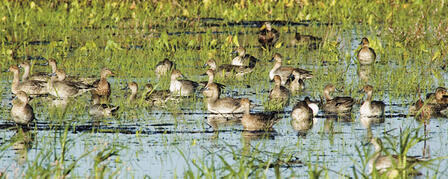DUCK POPULATION AT ALL-TIME HIGH

Prairie breeding grounds soaked
PRATT — Duck hunters will find plenty to cheer about in the U. S. Fish and Wildlife Service’s (USFWS) annual breeding population and habitat survey, released in early July. Conducted each May by USFWS and the Canadian Wildlife Service, this year’s survey reveals the second-highest pond count and a record 45.6 million ducks, the most since the survey was started in 1955. Blue-winged teal, shovelers, and redheads soared to record levels, and mallard, pintail, canvasback, and gadwall numbers rose substantially from 2010.
Across the U.S. side of the region, the last three years have been the wettest since pond counts began. The 3.2 million ponds inventoried in the U.S. this spring were the most on record. The 4.9 million ponds in prairie Canada were 43 percent more than the long-term average, which dates back to 1955, and brings the total pond count across the traditional survey area to 8.1 million, second only to the 8.3 million recorded in 1974.
Not surprisingly, all that water attracted a record number of ducks. The 12.5 million breeding ducks that settled in the eastern half of the Dakotas was the most ever and was 172 percent above average.
The Canadian prairies got drenched this year and also attracted significantly more ducks than last year. Alberta saw a 60-percent jump in pond numbers and 66 percent more ducks; Manitoba was 72 percent wetter with 41 percent more ducks; and Saskatchewan’s pond count rose 18 percent and attracted 56 percent more ducks.
Species reaching all-time highs include blue-winged teal at a whopping 8.9 million, northern shovelers at 4.6 million, and redheads at 1.4 million. Mallards improved to 9.2 million; pintails jumped to 4.4 million, the highest level since 1980; gadwalls rose to 3.3 million; canvasbacks climbed to 692,000, and scaup improved slightly to 4.3 million. Only American wigeon and green-winged teal saw declines although green-winged teal are still well above their long-term average.
The following chart reveals the changes in number of ponds from last year, as well as the changes in numbers of the 10 most common duck species in the Central Flyway, as well as the change from long-term averages.
| Species | 2011 (millions) | 2010 | % Change from 2010 | % Change long-term ave. |
| May Ponds (U.S. & Can.) | 8.132* | 6.665 | +22 | +62 |
| Total Ducks | 45.554* | 40.895 | +11 | +35 |
| Mallard | 9.183* | 8.430 | +9 | +22 |
| Gadwall | 3.257 | 2.977 | +9 | +80 |
| American Wigeon | 2.084 | 2.425 | -14 | -20 |
| Green-winged teal | 2.900 | 3.476 | -17 | +47 |
| Blue-winged teal | 8.948* | 6.329 | +41 | +91 |
| Northern shoveler | 4.641 | 4.057 | +14 | +98 |
| Northern Pintail | 4.429* | 3.509 | +26 | +10 |
| Redhead | 1.356 | 1.064 | +27 | +106 |
| Canvasback | 0.692 | 0.585 | +18 | +21 |
| Scaup | 4.319 | 4.244 | +2 | -15 |
*Indicates significant change from 2010
An uninterrupted wet cycle that began in the U.S. in 1994, millions of acres of dense nesting cover provided by the Conservation Reserve Program (CRP), and an outbreak of mange that has kept fox numbers in check are factors contributing unprecedented duck numbers in recent years.
The importance of CRP on the U.S. side of the “duck factory” becomes more apparent with each passing breeding season. For the third year in a row, more pintails settled in the eastern Dakotas (1.5 million) than in prairie Saskatchewan (1.1 million). Pintail numbers in the eastern Dakotas were a whopping 209 percent higher than average. The 8.9 million blue-wings were the most ever, and 61 percent of those ducks set up housekeeping on the U.S. side of the region. Redheads have also taken advantage of nesting conditions in the U.S. The 1.4 million breeders recorded this year set yet another record, and 654,000 of them — 241 percent more than average — settled in the U.S. Northern shovelers also set a record at 4.6 million, 98 percent higher than the long-term average. Shoveler numbers actually dropped across the eastern Dakotas, but rose dramatically in the prairie provinces and the western Dakotas.
The mallard breeding population rose less than some observers expected, still a very respectable 9.2 million, with 3.4 million of those in the U.S. Surveyors counted 18 percent more canvasbacks than a year ago; gadwalls were the third highest ever; and scaup climbed to the highest level since 1999, which is still 15 percent below average.
Species of concern are the American wigeon, which fell 14 percent from last year to 2.1 million and is now 20 percent below average, and green-winged teal, off 17 percent to 2.9 million but still 47 percent higher than average.
While the USFWS Fall Flight Forecast has yet to be completed, the number of nesting ducks bodes well for strong numbers once birds migrate south in the fall. Kansas hunters only need to hope for rain to ensure that birds stop as they migrate south this fall.
-30-









